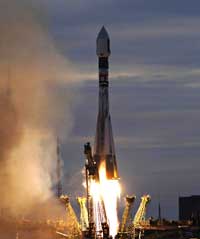ON OUR WAY TO VENUS!

Image courtesy ESA
On 9 November at 03:33 GMT ESA’s Venus Express was launched successfully towards Earth’s sister planet. After a few days delay caused by contamination at the launch pad, the cleaned spacecraft is now safely on its way. After one orbit of Earth, the upper Fregat stage of the rocket fired successfully, propelling the spacecraft out of Earth orbit and towards Venus.
Dr Andrew Coates, head of planetary science at MSSL-UCL and a co-investigator on the mission, said ‘The Russian Soyuz-Fregat has performed flawlessly. So far SO good! The lift-off was beautiful, a real textbook launch, and the nail-biting wait for the second burn of the Fregat after that first orbit was hugely worth it. We're on our way to explore Earth's evil twin, after the best possible start’.
The team at MSSL-UCL helped build ASPERA-4, an instrument to explore one of the differences between Venus and Earth – Venus lacks a magnetic field. Its atmosphere escapes as the solar wind, a gale of charged particles from the Sun, erodes its unprotected atmosphere.
Venus has the hottest planetary surface in the solar system (450°C – hot enough to melt lead), a runaway greenhouse effect, a thick atmosphere (92 times as thick as Earth’s), a slow rotation the wrong way round, hurricane force winds and strange vortices near the poles. Other instruments on the mission will look at the thick atmosphere of Venus below its sulphuric acid clouds and how it interacts with the surface. They will also try and understand the runaway greenhouse effect and search for active volcanism.
Venus Express is a wonderful mission of discovery - not only to find out why Earth's twin went wrong and to study its strange atmosphere now, but also to glimpse a possible future for the Earth. The extreme example of Venus will test models of our own atmosphere and humankind's contribution to greenhouse gases here. It will also give a preview of what it may be like in 2 billion years time when the Sun has got brighter in its evolution along the main sequence of stars. At that time Earth will no longer be in the 'Goldilocks' zone and our planet may become more like what Venus is like now.
In the meantime, says Dr Coates, ‘We can't wait to get the data. Generally, the comparison between Earth, Venus and Mars, and why Earth is so special, is scientifically exciting and important for our race. With our instrument, ASPERA, at Venus and Mars, we will compare the two unmagnetized planets and how their atmosphere escapes. Why does escape occur at both but leave very different atmospheric pressures at Venus (almost 100 times Earth's surface pressure) and Mars (a factor 100 less?) We will soon begin to find out.
Venus Express is due to arrive at our sister planet in April 2006.
![]() +44 (0)1483 204100 - Copyright © 1999-2005 UCL
+44 (0)1483 204100 - Copyright © 1999-2005 UCL